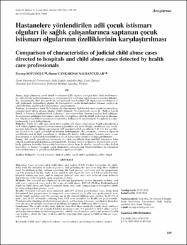Comparison of characteristics of judicial child abuse cases directed to hospitals and child abuse cases detected by health care professionals
Citation
Sofuoglu, Z., & Cankardas Nalbantcilar, S. (2018). Comparison of characteristics of judicial child abuse cases directed to hospitals and child abuse cases detected by health care professionals. Izmir Dr Behcet Uz Cocuk Hastanesi Dergisi, 8(3), 189-195. doi:10.5222/buchd.2018.77045Abstract
Objective: Cases of unrevealed child abuse and neglect (CAN) further traumatize the child, delay both the initiation of judicial process, and providing the necessary help these children need. In addition to this, without reporting, the legal process can't start and the perpetrator can't be punished. In this study, it was aimed to investigate the cases of CAN recorded in four hospitals within one year, and to compare judicial cases and cases referred from different departments of the hospitals upon suspicion of abuse.Methods: The research was conducted in relevant departments of four hospitals in Izmir, and with cases registered cases under the scope of child abuse. BECAN (Balkan Epidemiological Study on Child Abuse and Neglect) transfer forms were used. Comparisons of Group were made by using independent groups' t-test.Results: A total of 352 cases were contacted, and 55% of them were forensic cases. It has been determined that perpetrators in suspected cases referred by health care professionals were mostly family members and the average age of the abused children were smaller. So 41.3% of males and 24.6% of females suffering from CAN were identified by healthcare professionals. Problems with schooling, alcohol/substance abuse, self-harming behaviors, psychiatric disorders were the most frequently encountered problems in exploited children in this research. Conclusion: The results of this study indicate that child abuse inside the family circle and boys who experienced CAN are remained hidden at a higher rate. It is possible to detect abuse earlier and make interventions by informing parents, schools, social services, police and primary health care workers, about the types of abuse and the symptoms that appear in children who are exposed to them.


















